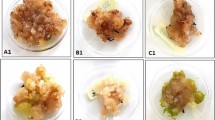Abstract
Proline content, ion accumulation, cell wall and soluble peroxidase activities were determined in control and salt-treated calli (150 nM NaCl) and whole plants (30 mM NaCl) of two rice cultivars (salt sensitive cv. IKP and salt tolerant cv. Aiwu). Under salinity, the highest accumulation of Na+, Cl− and proline occurred in calli, roots and younger leaves of cv. IKP, coupled with the highest decrease in K+ content; accumulations of Na+ and Cl− were restricted to older leaves in cv. Aiwu. Relative growth rates of calli and roots or shoots from both cultivars were not linked to peroxidase activities. High concentrations (1 M) of exogenously applied glycerol did not inhibitin vitro activities of soluble peroxidase extracted from control and salt-treated calli or plants. Conversely, 35–55% (in cv. IKP) or 60–80% (in cv. Aiwu) of soluble peroxidase activities were found in presence of isosmotic proline concentration. There were no differences between proline and glycerol effects onin vitro cell wall peroxidase activities.
Similar content being viewed by others
Abbreviations
- IAA:
-
indole acetic acid
- IKP:
-
I Kong Pao
References
Bates, L.S., Waldren, R.P., Teare, I.D.: Rapid determination of free proline for water stress studies. —Plant Soil39: 205–207, 1973.
Bourgeais-Chaillou, P., Guerrier, G.: Salt responses inLycopersicon esculentum calli and whole plants.—J. Plant Physiol.140: 494–501, 1992.
Bourgeais-Chaillou, P., Pérez-Alfocea, F., Guerrier, G.: Evolution ontogénique de la tolérance au NaCl chez le soja: comparaison des résponses au sel à deux stades de développement et chez les cals correspondants.—Can. J. Bot.70: 1346–1354, 1992.
Fieldes, M.A., Gerhardt, K.E.: Effects of Zn on flax seedlings: differences in the response of the cationic and anionic isozymes of peroxidase.—Plant Sci.96: 1–13, 1994.
Gaspar, T., Penel, C., Castillo, F.J., Greppin, H.: A two-step control of basic and acidic peroxidases and its significance for growth and development.—Physiol. Plant.64: 418–423, 1985.
Greenway, H., Munns, R.: Mechanisms of salt tolerance in nonhalophytes.—Annu. Rev. Plant Physiol.31: 149–190, 1980.
Guerrier, G.: Effets du NaCl sur les capacités oxydases durant la germination de semences de plantes sensibles ou tolérantes au sel.—Biol. Plant.29: 299–306, 1987.
Heimer, Y.M.: The effects of sodium chloride, potassium chloride and glycerol on the activity of nitrate reductase of a salt-tolerant and two non-tolerant plants.—Planta113: 279–281, 1973.
Lowry, O.H., Rosenbrough, N.J., Farr, A.J., Randall, R.J.: Protein measurement with the Folin phenol reagent.—J. biol. Chem.193: 265–275, 1951.
Lutts, S., Bouharmont, J.:In vitro selection for salt tolerance in rice: the possible involvement of ethylene.—In: Fritig, B., Legrand, M. (ed.): Mechanisms of Plant Defense Responses. Pp. 174–175. Kluwer Academic Publishers, Dordrecht-Boston-Lancaster 1993.
MacAdam, J.W., Nelson, C.J., Sharp, R.E.: Peroxidase activity in the leaf elongation zone of tall fescue. I. Spatial distribution of ionically bound peroxidase activity in genotypes differing in length of the elongation zone.—Plant Physiol.99: 872–878, 1992.
Maehly, P.C., Chance, M.: The assay of catalase and peroxidases.—In: Gluck, D. (ed.): Methods of Biochemical Analysis. Pp. 357–424. Interscience Publishers, New York 1954.
Manetas, Y.: A re-examination of NaCl effects on phosphoenolpyruvate carboxylase at high (physiological) enzyme concentrations.—Physiol. Plant.78: 225–229, 1990.
Mittal, R., Dubey, R.S.: Behaviour of peroxidases in rice: changes in enzyme activity and isoforms in relation to salt tolerance.—Plant Physiol. Biochem.29: 31–40, 1991.
Nikolopoulos, D., Manetas, Y.: Compatible solutes andin vitro stability ofSalsola soda enzymes: proline incompatibility.—Phytochemistry30: 411–413, 1991.
Pérez-Alfocea, F., Estãn, M.T., Caro, M., Guerrier, G.: Osmotic adjustment inLycopersicon esculentum andL. pennellii under NaCl and polyethylene glycol 6000 iso-osmotic stresses.— Physiol. Plant.87: 493–498, 1993.
Pollard, A., Wyn Jones, R.G.: Enzyme activities in concentrated solutions of glycinebetaine and other solutes.—Planta144: 291–298, 1979.
Siegel, B.Z.: Plant peroxidases—an organismic perspective.—Plant Growth Regul.12: 303–312, 1993.
Smirnoff, N.: The role of active oxygen in the response of plants to water deficit and dessication.— New Phytol.125: 27–58, 1993.
Smirnoff, N., Cumbes, Q.J.: Hydroxyl radical scavenging activity of compatible solutes.— Phytochemistry28: 1057–1060, 1989.
Stevens, H.C., Calvan, M., Lee, K., Siegel, Z.: Peroxidase activity as a screening parameters for salt stress inBrassica species.—Phytochemistry17: 1521–1522, 1978.
Stewart, G.R., Lee, J.A.: The role of proline accumulation in halophytes.—Planta120: 279–289, 1974.
Yeo, A.R., Flowers, T.J.: Salinity resistance in rice (Oryza sativa L.) and a pyramiding approach to breeding varieties to saline soils.—In: Turner, N.C., Passioura, J.B. (ed.): Plant Growth, Drought and Salinity. Pp. 161–175. CSIRO Publishers, Canberra 1986.
Yeo, A.R., Yeo, M.E., Flowers, S.A., Flowers, T.J.: Screening of rice (Oryza sativa L.) genotypes for physiological characters contributing to salinity resistance and their relationship to overall performance.—Theor. appl. Genet.79: 377–384, 1990.
Yoshida, S., Forno, O.A., Cock, J.H., Gomez, K.A.: Laboratory Manual for Physiological Studies of Rice.—International Rice Research Institute, Manila 1976.
Zheng, X., Van Huystee, R.B.: Anionic peroxidase catalysed ascorbic acid and IAA oxidation in the presence of hydrogen peroxide—a defence system against peroxidative stress in peanut plant.— Phytochemistry31: 1895–1899, 1992.
Author information
Authors and Affiliations
Rights and permissions
About this article
Cite this article
Lutts, S., Guerrier, G. Peroxidase activities of two rice cultivars differing in salinity tolerance as affected by proline and NaCl. Biol Plant 37, 577–586 (1995). https://doi.org/10.1007/BF02908842
Received:
Accepted:
Issue Date:
DOI: https://doi.org/10.1007/BF02908842




